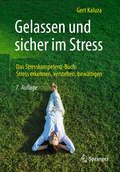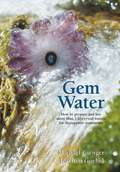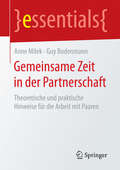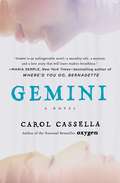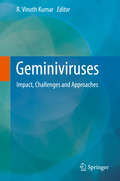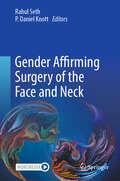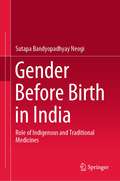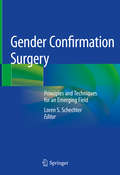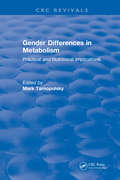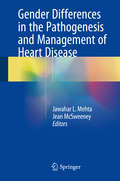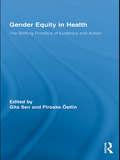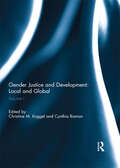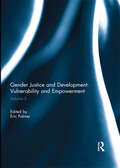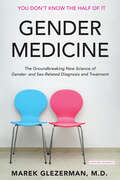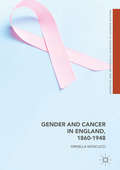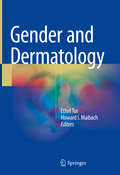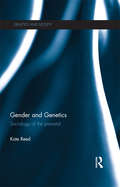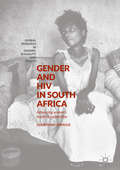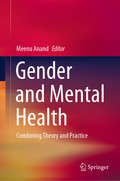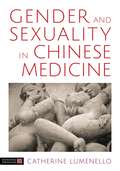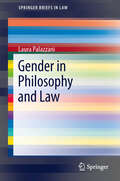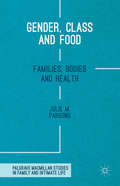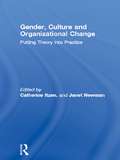- Table View
- List View
Gelassen und sicher im Stress: Das Stresskompetenz-Buch: Stress erkennen, verstehen, bewältigen
by Gert Kaluza„Gestresst!“ – „Keine Zeit!“ – „Ich weiß nicht, wo mir der Kopf steht!“ Stress kennt fast jeder, und viele leiden unter den negativen Folgen von Dauerstress. Was also tun? Dieses Buch zeigt vielfältige Handlungsmöglichkeiten auf und macht Mut für den eigenen Weg zu einem gelassenen und gesunden Umgang mit Stressbelastungen in Beruf und Alltag. Es ist geschrieben für Stressgeplagte zur Selbsthilfe und als verständliche Begleitlektüre bei Stressbewältigungskursen oder im Rahmen einer Beratung, für Personalverantwortliche und Führungskräfte in Wirtschaft und Verwaltung, auch für beratend und therapeutisch Tätige, die stressbelastete Personen unterstützen, und für alle, die ihre persönliche Stresskompetenz weiterentwickeln wollen. Aus dem Inhalt: Instrumentelle Stresskompetenz: den Alltag stressfreier gestalten, Anforderungen aktiv begegnen – Mentale Stresskompetenz: förderliche Einstellungen und Bewertungen entwickeln – Regenerative Stresskompetenz: Ausgleich schaffen, entspannen und erholen – Mit Checklisten, erprobten Übungen und praktischen Tipps. Der Autor: Prof. Dr. Gert Kaluza ist psychologischer Psychotherapeut und als Trainer, Coach und Autor im Bereich der individuellen und betrieblichen Gesundheitsförderung tätig. Nach 20jähriger Tätigkeit an verschiedenen Universitäten gründete er 2002 ein eigenes Fortbildungs- und Trainingsinstitut, das GKM-Institut für Gesundheitspsychologie, das er bis 2022 selbst leitete.
Gelassen und sicher im Stress: Das Stresskompetenz-buch: Stress Erkennen, Verstehen, Bewältigen
by Gert Kaluza„Gestresst!“ – „Keine Zeit!“ – „Ich weiß nicht, wo mir der Kopf steht!“ Stress kennt fast jeder, und viele leiden unter den negativen Folgen von Dauerstress. Was also tun? Dieses Buch zeigt vielfältige Handlungsmöglichkeiten auf und macht Mut für den eigenen Weg zu einem gelassenen und gesunden Umgang mit Stressbelastungen in Beruf und Alltag. Es ist geschrieben für Stressgeplagte zur Selbsthilfe und als verständliche Begleitlektüre bei Stressbewältigungskursen oder im Rahmen einer Beratung, für Personalverantwortliche und Führungskräfte in Wirtschaft und Verwaltung, für Berater und Therapeuten, die stressbelastete Klienten unterstützen, und für alle, die ihre persönliche Stresskompetenz weiterentwickeln wollen.Aus dem Inhalt: Instrumentelle Stresskompetenz: den Alltag stressfreier gestalten, Anforderungen aktiv begegnen – Mentale Stresskompetenz: förderliche Einstellungen und Bewertungen entwickeln – Regenerative Stresskompetenz: Ausgleich schaffen, entspannen und erholen – Mit Checklisten, Übungen und zahlreichen Tipps.Der Autor: Prof. Dr. Gert Kaluza ist psychologischer Psychotherapeut und als Trainer, Coach und Autor im Bereich der individuellen und betrieblichen Gesundheitsförderung tätig. Nach über 20jähriger Tätigkeit an verschiedenen Universitäten gründete er 2002 sein eigenes Fortbildungs- und Trainingsinstitut, das GKM-Institut für Gesundheitspsychologie.
Gem Water
by Michael Gienger Joachim GoebelEffective and healthy remedies produced by infusing water with appealing crystalline energies are carefully described in this informative manual. The first part covers aspects of preparation, featuring deceptively simple processes such as the boiling method, the water vapor method, and the test tube method-all of which can be easily mastered by crystal healing enthusiasts. After outlining the correct methods to use and listing poisonous crystals as a safety precaution, the book examines more than 100 usable crystals and 34 special mixtures, revealing their intended uses and effects for the optimum in therapeutic results.
Gemeinnützige Krankenhäuser im Gemeinnützigkeitsrecht und im europäischen Beihilferecht (Schriften zum Stiftungs- und Gemeinnützigkeitsrecht)
by Luisa Margitta BraunWährend sich das Gemeinnützigkeitsrecht grundsätzlich durch seine Marktferne auszeichnet, verlangt das Europarecht größtmöglichen Wettbewerb. Trotz dieser Dichotomie muss sich der nationale Gesetzgeber auch bei Steuervergünstigungen für gemeinnützige Zwecke an das Unionsrecht halten. Die Frage, ob Steuererleichterungen zugunsten gemeinnütziger Einrichtungen mit dem Unionsrecht und insbesondere mit dem Beihilferecht vereinbar sind, verdichtet sich bei Trägern sogenannter Zweckbetriebe. Diese unterhalten einen wirtschaftlichen Geschäftsbetrieb, treten mit diesem in den Wettbewerb und sei es zur Verwirklichung gemeinnütziger Zwecke. Für die Untersuchung greift die Arbeit exemplarisch den Zweckbetrieb des Krankenhauses heraus, bei welchem sich einerseits der Zwiespalt zwischen Wettbewerb und Gemeinwohlorientierung besonders verdichtet, sich andererseits aber unionsrechtlich über Artikel 106 Absatz 2 AEUV gemeinwohlorientiert lösen lässt.
Gemeinsame Zeit in der Partnerschaft: Theoretische und praktische Hinweise für die Arbeit mit Paaren (essentials)
by Guy Bodenmann Anne MilekDieses essential thematisiert das Zusammenspiel zwischen Qualit#65533;t und Quantit#65533;t gemeinsam verbrachter Zeit in einer Partnerschaft - orientiert am Beratungsbedarf in Psychotherapie, Familien- und Paarberatung. Auch wenn Paare heutzutage vergleichsweise mehr Freizeitaktivit#65533;ten gemeinsam nachgehen als in den vergangenen Jahrzehnten, berichten viele, nicht gen#65533;gend Zeit f#65533;r Familie und Partnerschaft zu haben. Eine Mehrheit von Paaren ist hohem allt#65533;glichen Stress ausgesetzt, der dazu f#65533;hrt, dass die gemeinsame Zeit f#65533;r Zweisamkeit, N#65533;he und Austausch eng bemessen ist. Dabei ist die gemeinsam verbrachte Zeit mit dem Partner ein zentraler Faktor f#65533;r eine gl#65533;ckliche Partnerschaft. Aus der aktuellen Paar- und Familienforschung leiten die Autoren Hinweise ab, wie Paare aktiv einem Zerfall der gemeinsamen Zeit entgegenwirken k#65533;nnen.
Gemini: A Novel
by Carol CassellaA stranger's life hangs in the balance. What if you had the power to decide if she lives or dies? Dr. Charlotte Reese works in the intensive care unit of Seattle's Beacon Hospital, tending to patients with the most life-threatening illnesses and injuries. Her job is to battle death--to monitor erratic heartbeats, worry over low oxygen levels, defend against infection and demise. One night a Jane Doe is transferred to her care from a rural hospital on the Olympic Peninsula. This unidentified patient remains unconscious, the victim of a hit and run. As Charlotte and her team struggle to stabilize her, the police search for the driver who fled the scene. Days pass, Jane's condition worsens, and her identity remains a mystery. As Charlotte finds herself making increasingly complicated medical decisions that will tie her forever to Jane's fate, her usual professional distance evaporates. She's plagued by questions: Who is Jane Doe? Why will no one claim her? Who should decide her fate if she doesn't regain consciousness--and when? Perhaps most troubling, Charlotte wonders if a life locked in a coma is a life worth living. Enlisting the help of her boyfriend, Eric, a science journalist, Charlotte impulsively sets out to uncover Jane Doe's past. But the closer they get to the truth, the more their relationship is put to the test. It is only when they open their hearts to their own feelings toward each other--and toward life itself--that Charlotte and Eric will unlock Jane Doe's shocking secret, and prepare themselves for a miracle. Filled with intricate medical detail and set in the breathtaking Pacific Northwest, Gemini is a riveting and heartbreaking novel of moral complexity and emotional depth.
Geminiviruses: Impact, Challenges and Approaches
by R. Vinoth KumarThis book provides in-depth information on all key aspects of geminivirus biology, e.g. the genetics and evolution, global diversity and spread of these plant pathogens, as well as the molecular mechanisms underlying their virulence. Geminiviridae is one of the largest viral families, comprising numerous plant-infecting viruses that cause diseases in crops and weeds. These diseases have been reported from nearly all continents, in particular Asia, Europe, Africa and America. The book summarizes the current state of knowledge on the interactions between plant host and virus. In addition, it discusses advances regarding the trans-replication of satellite molecules and its effect on geminiviral pathogenesis, as well as pest management strategies to combat these diseases in the field. Given its scope, the book is a must-read reference guide for all researchers and advanced students working in virology, agriculture and plant biotechnology..
Gender Affirming Surgery of the Face and Neck
by Rahul Seth P. Daniel KnottThis book presents an overview of Facial gender confirming surgery (FGCS) and the importance of it in the surgery and transgender communities. FGCS uniquely requires blending together surgical and artistic abilities in order to transform the face into a new identity. Given the recent emphasis of providing care to transgender patients, the area of FGCS has experienced rapid evolution and growth. This text is essential to protect patients and arm surgeons with the knowledge needed to safely perform these surgeries. This text is divided into three parts to let the reader fully digest what FGCS includes. Part 1 discusses general care of the transgender patient and provides the physician with an overview of the health and societal issues specific to this patient population. Part 2 is the main focus of the book and discusses facial gender confirming surgery and such as feminizing surgeries. Lastly, part 3 discusses voice surgery and voice therapy. Gender Affirming Surgery of the Face and Neck can be applied in multiple medical fields, including Otolaryngology- Head and Neck Surgery, Facial Plastic Surgery, Plastic Surgery, Oral and Maxillofacial Surgery, Laryngology, Speech Pathology, Oculoplastic Surgery, and Dermatology.
Gender Before Birth in India: Role of Indigenous and Traditional Medicines
by Sutapa Bandyopadhyay NeogiThis book focuses on the role of the indigenous system of medicine or traditional medicines in gender selection in India. Issues such as the harmful effects of traditional practices on the health of the woman and the foetus during early pregnancy are explored in this book. It analyses the social and cultural practices and establishes linkages with modern methods of scientific investigations. It discusses how systematic exploration lends evidence of harmful traditional practices. The book is an important read for researchers, healthcare professionals and students in the field of medicine, public health and social sciences. It is an extremely valuable resource for all those engaged in research of traditional and modern systems of medicine.
Gender Confirmation Surgery: Principles and Techniques for an Emerging Field (The\clinics: Surgery Ser. #45-3)
by Loren S. SchechterGender confirming surgery represents one of many therapies for individuals with gender dysphoria and can be pivotal in allowing individuals to become their true selves. An emerging field, this text represents a continuing evolution of surgical techniques, as well as a framework around which surgical therapies are based. Providing a fundamental understanding of the surgical principles while also recognizing the fast-paced nature of the advances in technique, Gender Confirmation Surgery touches upon the challenges and complexities in the surgical care of transgender individuals, featuring detailed sections for transwomen and transmen surgeries, non-surgical options, and establishing educational programs.Written as a guide primarily for surgeons in plastics, urology, and gynecology, this book can also appeal to primary care practitioners, mental health professionals, and endocrinologists. By representing an evolution of technique and advances in the field, Gender Confirmation Surgery offers a framework around which practitioners can familiarize themselves with gender surgery.
Gender Differences in Metabolism: Practical and Nutritional Implications
by Mark TarnopolskyGender Differences in Metabolism: Practical and Nutritional Implications is the first book to successfully integrate nutritional science, exercise physiology/medicine, and metabolism. This volume explores recent scientific evidence that male and female athletes exhibit different metabolic responses and, therefore, differ in their nutritional needs and advice. Anyone interested in good health, exercise, and nutrition will find this book a valuable resource.
Gender Differences in the Pathogenesis and Management of Heart Disease
by Jawahar L. Mehta Jean McSweeneyThis book reviews all aspects of the diagnosis and management of heart disease in women, covering areas such as gender differences in metabolic syndrome, hypertension and atherogenesis. Gender differences in cardiovascular diseases are widespread, but while gender medicine takes into account the effects of sex and gender on the health of women and men, traditionally, women have been underrepresented in cardiovascular clinical trials, in management of different cardiac diseases and drug use. Gender Differences in the Pathogenesis and Management of Heart Disease deals with the gender-specific differences in cardiac physiology and diseases and brings into perspective the critical significance of gender in management of cardiovascular disease presentations and management. As such it is of enormous use to all clinical staff who manage women with cardiovascular disease.
Gender Equity in Health: The Shifting Frontiers of Evidence and Action (Routledge Studies in Health and Social Welfare)
by Gita Sen Piroska ÖstlinThis volume brings together experts from a variety of disciplines, such as medicine, biology, sociology, epidemiology, anthropology, economics and political science, who focus on three areas: health disparities and inequity due to gender, the specific problems women face in meeting the highest attainable standards of health, and the policies and actions that can address them. Highlighting the importance of intersecting social hierarchies (e.g. gender, class and ethnicity) for understanding health inequities and their implications for health policy, contributors detail and recommend policy approaches and agendas that incorporate, but go beyond commonly acknowledged issues relating to women’s health and gender equity in health.
Gender Justice and Development: Volume I
by Christine M. Koggel and Cynthia BismanIt is now generally accepted by development theorists and policy-makers that the popular policies of reducing or eliminating social welfare programs over the past several decades have increased inequalities and injustices throughout the world. The authors in this collection focus on the gendered aspects of these inequalities and injustices. They do so by exploring the ethics, values, and principles central to understanding and alleviating real-world problems resulting from a lack of gender justice locally and globally.Some of the authors offer new theoretical and conceptual frameworks in order to analyze connections between gender norms and inequalities, to devise strategies to empower women and strengthen communities, to challenge mainstream understandings of justice and responsibility, to promote caring and just relationships among people within and across borders, or to shape more adequate accounts of development and global ethics. Other authors apply new theories and concepts in order to explore gender justice in the context of issues such as climate change, land ownership rights in Cameroon, or empowerment strategies in places such as Afghanistan, Bangladesh, Ghana, Columbia, and Indonesia. This book was originally published as a special issue of Ethics and Social Welfare.
Gender Justice and Development: Volume II
by Eric PalmerVulnerability and empowerment are central concepts of contemporary development theory and ethics. Vulnerability associated with human interdependence is a wellspring of values in care ethics, while vulnerability arising from social problems demands remedy, of which empowerment is frequently the just form. Development planners and aid providers focus upon improving the wellbeing of the most vulnerable – especially women – by empowering them economically, socially and politically.Both vulnerability and empowerment are considered in this volume. Drydyk argues that empowerment is necessarily relational, not simply a matter of expanding choices. Koggel reviews Drydyk’s discussion through the lens of feminist relational theory, considering how norms, structures and institutions shape, delimit, and promote empowerment. Presbey examines empowerment in East African women’s lives through the writings and biography of Wangari Maathai. Kosko considers indigenous self-governance and participation in shared governance. Khader reflects upon postcolonial feminist criticism of the concept of adaptive preference. Panitch discusses the economic vulnerability that surrounds the global market in surrogate birth. Pandey provides a review of third world eco-feminist activism and literature. Cudd envisions international humanitarian intervention to support female autonomy against oppressive state and social institutions. This book was originally published as a special issue of the Journal of Global Ethics.
Gender Medicine: The Groundbreaking New Science of Gender- and Sex-Related Diagnosis and Treatment
by Marek GlezermanAn exploration of how to bring medicine into the twenty-first century with our understanding of gender and sex differences. Over millions of years, male and female bodies developed crucial physiological differences to improve the chances for human survival. These differences have become culturally obsolete with the overturning of traditional gender roles. But they are nevertheless very real, and they go well beyond the obvious sexual and reproductive variances: men and women differ in terms of digestion, which affects the way medications are absorbed. Sensitivity to pain is dependent on gender. Even the symptoms of a heart attack manifest differently in a man than in a woman. And yet the medical establishment largely treats male and female patients as though their needs are identical. In fact, medical research is still done predominately on men, and the results are then applied to the treatment of women. This is clearly problematic and calls for a paradigm change—such a paradigm change is the purpose of Gender Medicine.Praise for Gender Medicine &“Gender Medicine is cutting edge in that the author challenges the historical and antiquated paradigms that women and men are interchangeable with respect to their physiology, pharmacology and pathophysiology excluding their reproductive organs. There is a shocking paucity of resource material showcasing the most current and complete evidence on sex and gender-based medicine. Marek Glezerman&’s book is a comprehensive and pleasurable read; it will enlighten both medical and nonmedical audiences and is highly applicable to the effective clinical practice of medicine in the twenty-first century.&” —Alyson J. McGregor M.D., MA, FACEP, Director, Division of Sex and Gender in Emergency Medicine (SGEM), Warren Alpert Medical School of Brown Universit &“This fascinating work will teach readers a great deal about sex, gender, and the human body. A must-read for health-care practitioners and anyone interested in medicine.&” —Library Journal, starred review
Gender and Cancer in England, 1860-1948
by Ornella MoscucciThis volume focuses on gynaecological cancer to explore the ways in which gender has shaped medical and public health responses to cancer in England. Rooted in gendered perceptions of cancer risk, medical and public health efforts to reduce cancer mortality since 1900 have prominently targeted women's cancers. Women have also been key participants in the 'war' on cancer through their various roles as medical practitioners, midwives, nurses, health visitors, radiotherapists and cytotechnicians. Moscucci's study traces this complex history from the establishment of 'early detection and treatment' policies aimed at cervical cancer, to the controversial development of prophylactic oophorectomy as a strategy for the prevention of ovarian cancer. Women's cancers are highly visible in modern English society as symbols of progress in cancer therapy and prevention. The account offered in this volume reveals a different story, marked by hopes and fears, expectations and disappointments.
Gender and Dermatology
by Howard I. Maibach Ethel TurThis book comprehensively reviews the characteristics of the body reflected in the skin due to differences in gender. It investigates the genetic and hormonal differences that can affect skin structure and function, and resulting in variations between women and men. The aging process and exogenous factors that differ according to differences in lifestyle between the sexes are also covered. Gender and Dermatology comprehensively outlines the various aspects of physiological differences between the skin of women and men using practical examples and review of the basic science. It is therefore an important clinically-relevant review for both the trainee and experienced practitioner in dermatology, primary care, geriatrics and immunology, while also being of interest to researchers in genetics and metabolic medicine.
Gender and Genetics: Sociology of the Prenatal (Genetics and Society)
by Kate ReedPrenatal screening for genetic disorders is becoming an increasingly widespread phenomenon across the globe. While studies have highlighted the importance of women’s experiences of such screening, little is known about men’s roles and direct involvement in this process. With a focus on the experiences of both women and men, this text offers an innovative and passionate account of the gendered nature of prenatal screening. Drawing on interview data with pregnant women and their male partners in a UK city, Reed provides a compelling analysis of maternal and paternal roles in prenatal screening. Through this analysis, the book raises important issues around genetics, gender and screening practice. With a focus on the gendered production of ‘good’ and ‘bad’ genes, the book explores differences between visual technologies and blood screening. It also explores the gendered nature of genetic responsibility and the impact this has on parenting roles. Extending its arguments into other key debates in prenatal genetics – including a focus on the impact of screening on other types of stratification, including ethnicity and class – Reed provides an original and comprehensive analysis of some of the most pressing concerns in the field to date. This book will be of interest to students and scholars of the sociology of health and illness, science and technology studies, gender studies, feminist bioethics and medical anthropology, as well as professionals in the fields of midwifery and genetic counselling.
Gender and HIV in South Africa: Advancing Women's Health And Capabilities (Global Research In Gender, Sexuality And Health Ser.)
by Courtenay SpragueThis book addresses the ongoing problem of HIV in black South African women as a health inequity. Importantly, it argues that this urgent problem of justice is changeable. Sprague uses the capabilities approach to bring a theory of health justice, together with multiple sources of evidence, to investigate the complex problem of HIV and accompanying poor health outcomes in black South African women. Motivated by a concern for application of knowledge, this work discusses how to better conceptualise what health justice demands of state and society, and how to mobilise available evidence on health inequities in ways that compel greater state action to address problems of gender and health. HIV in women, and possible responses, are investigated on four distinct levels: conceptual, social structure, health systems, and law. The analysis demonstrates that this problem is indeed modifiable with long-term interventions and an enhanced state response targeted at multiple levels. This book will be of interest to academics and students in the social health sciences, gender and development studies, and global health, as well as HIV/health activists, government officials, policy makers, HIV clinicians and health providers interested in HIV.
Gender and Mental Health: Combining Theory and Practice
by Meenu AnandThis book focuses on various aspects of gender and mental health. Drawing on multidisciplinary perspectives and scholarship, it summarizes the complex intertwining of illness and culture in the context of the rising frequency of mental disorders. The book is divided into three sections, the first of which examines the fundamental and conceptual underpinnings of mental health, well-being and wellness from a gender perspective, in order to present an overview of mental health through a holistic gender lens. The second section focuses on the mental health scenario in India, examining the epidemiological data and etiology of mental illness from a psychosocial standpoint. Lastly, the third section shares field-based narratives that reflect the multifaceted challenges related to the treatment of mental illness, inclusion and the promotion of positive mental health. It also includes success stories in diverse settings. The book is an indispensable read for scholars and professionals in psychology, sociology, gender studies and social work.
Gender and Sexuality in Chinese Medicine: The Merging Of Yin And Yang
by Catherine J. LumenelloThis progressive handbook for Chinese medicine students and practitioners looks at gender, physiology, relationships and sexual attraction from the Chinese medicine perspective. Many standard diagnostic and treatment techniques are gender-based and do not work with clients who identify as LGBT or gender/sex/relationship fluid and so these communities are currently often underserved.Catherine Lumenello accesses the Daoist, Buddhist and Confucianist roots of the medicine and explores the energetic pathways, the Three Treasures and other theories in order to understand the emotional etiology and treatment concerns prevalent within these client groups. The topics covered in the book include transgender issues, asexuality, sex addiction, sexual realignment surgery and polyamory. Incorporating client examples, illustrations, and an assortment of treatment approaches, this book is a radical re-examination of the potential of Chinese medicine.
Gender in Philosophy and Law
by Laura PalazzaniThis book is an introductory systematic framework in the complex and interdisciplinary sex/gender debate, focusing on philosophy of law.The volume analyses the different theories that have dealt with the gender category, highlighting the conceptual premises and the arguments of the most influential theories in the debate, which have had repercussions on the field of the ethical and juridical debate (with reference to intersexuality, transsexualism, transgender, homosexuality). The aim is to offer a sort of conceptual orientation in the complexity of the debate, in an effort to identify the various aspects and development processes of the theories, so as to highlight the conceptual elements of the theorisations to grasp the problem areas within them. It is therefore an overall synthetic and also explicative analysis, but not only explicative: the aim is to outline the arguments supporting the different theories and the counter-arguments too, for the purpose of proposing categories to weigh up the elements and to take one's own critical stance, with a methodological style that is neither descriptive nor prescriptive, but critical.
Gender, Class and Food: Families, Bodies and Health (Palgrave Macmillan Studies in Family and Intimate Life)
by Julie M. ParsonsEveryday foodways are a powerful means of drawing boundaries between social groups and defining who we are and where we belong. This book draws upon auto/biographical food narratives and emphasises the power of everyday foodways in maintaining and reinforcing social divisions along the lines of gender and class.
Gender, Culture and Organizational Change: Putting Theory into Practice
by Janet Newman Catherine ItzinAn engaging contribution to the increasing body of knowledge about gender and organizations, Gender, Culture and Organizational Change examines gender-based inequality in organizations and considers how sexual and social relations between women and men based on sexuality, power and control determine the cultures, structures and practices of organization and the experiences of men and women working in them. Gender, Culture and Organizational Change represents a decade of experience of managing change and implementing theory in public sector organizations during a period of major social, political and economic transition and analyses the progress that has been made. It expands to make wider connections with women and trade unions in Europe and management development for women in the "developing" countries of Africa and Asia. It will be valuable reading for students in social policy, gender studies and sociology and for professionals with an interest in understanding the dynamics of the workplace.

